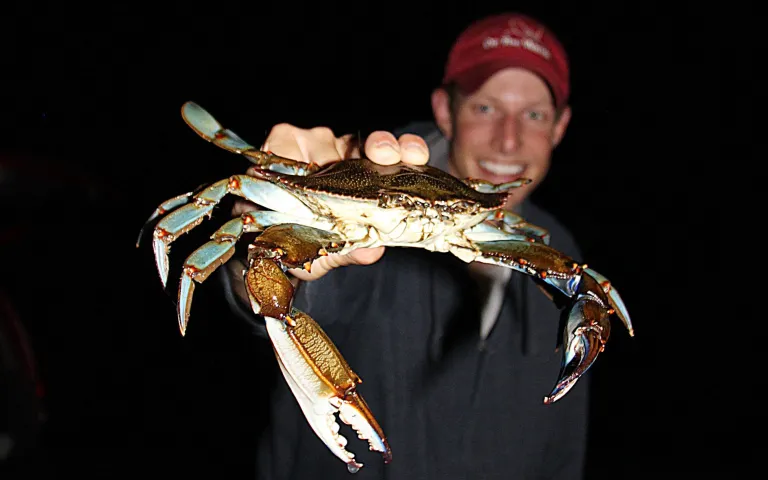by CARRIE GENTILE Photos By ANDY NABRESKI
Blue crabs have paddle-shaped back legs called swimmerettes that help glide them briskly though water to their destination, adding credence to their nickname of beautiful swimmers. And inside their shells lies succulent meat akin to lobster, only sweeter.
Known for their abundance on the Chesapeake Bay, these crustaceans can be found in brackish bays and estuaries from Nova Scotia to the Gulf of Mexico.

It is not uncommon to see people “crabbing” on Cape Cod, usually beginning in August when the crabs have grown to a respectable size filled, with your soon to be dinner. Typically, a person can eat between a half-dozen to a dozen crabs in one go with an average of two ounces of meat in each crab.
Catching crabs can be fun and does not require many tools. But be careful; they are feisty at best and can be downright ferocious with their claws. They have eyes that can see in most directions and serrated claws that they will use. Just look to my golden retriever who lost a fight with a crab that locked onto his curious snout.

Blue Crabs, named for their allover blueish hue and either blue or red tipped claws, move in and out of estuaries with the tides, so look for them in moving water. The ponds near Black Beach off the Shining Sea Bikeway or West Falmouth Harbor offer prime crabbing real estate. They like muddy or sandy bottoms. I have seen them in many of Falmouth’s salt pond channels heading out to sea.
The tools of the crabbing trade couldn’t be simpler.
One method requires a long handled net, a five-gallon bucket, and an old pair of sneakers. Perhaps waders too. You have to act quickly once you see a crab swimming along, but once it’s in your net, shake him out and into the bucket. And repeat. Do not force it out; remember, they have attitude.
Do not fill the bucket with water and do not leave them in there too long or they will begin to fight each other resulting in torn off claws.
Another method from shore is called chicken-necking, which involves dropping fishing line with raw chicken parts on it into the water and waiting. If you have a dock, you can string up several of these to catch dinner. Once the string begins to jiggle, grab it and steadily pull it in and net it.
As far as regulations, Falmouth’s are the same as the state’s. No permit is required for crabbing unless you are using a trap or scuba equipment, then you are need a recreational trap permit. The daily limit is 25 crabs that are at least 5-inches in shell width. Egg bearing females are off limits. Closed season on harvest is January 01–April 30, inclusive. Closed season on trap gear is November 1 – May 15, inclusive.
Males tend to have more meat in them. The difference between a male and a female crab can be determined by the bottom of the shell; males have a tapered abdomen that resembles an inverted T. I think it looks like the Washington Monument. Females have a rounded abdomen. Females also have red-tipped claws.
Cooking them requires steaming, with or without Old Bay Seasoning, and dumping them onto a picnic table covered in newspaper. With mallet in hand, begin cracking and cleaning all the meat you can. Drawn butter is optional.

